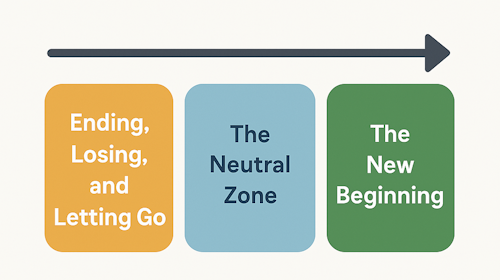Bridges' Transition Model
Emphasizes internal psychological transitions.
"It isn't the changes that do you in, it's the transitions. Change is situational. Transition is psychological." 1

Developed by William Bridges, the Transition Model focuses not on the external change itself, but on the internal psychological transition people experience as they adapt. In Agile environments, where change is continuous, new roles, restructured teams, evolving processes, understanding the inner landscape of transition is crucial for sustaining momentum and morale.
Bridges distinguishes change (situational, external) from transition (emotional, internal), breaking the latter into three phases:
- Ending, Losing, and Letting Go
- The Neutral Zone
- The New Beginning
Each phase requires distinct support, especially in Agile settings where resistance, uncertainty, or burnout can derail progress.
Impact on Agile Teams
Agile transformations, whether introducing Scrum, shifting team structures, or adopting DevOps, are often framed in terms of new practices. However, their success hinges on the emotional readiness of the individuals involved. Bridges. model reveals that:
- Teams might cling to old norms, even when Agile rituals are in place.
- The Neutral Zone can be fertile ground for innovation, but also confusion.
- Leaders may push for quick adoption, overlooking unresolved emotions tied to what was lost.
Without guiding teams through transition, Agile can become performative rather than transformative.
Scenario
A product company adopts Scrum across all departments. Teams are restructured, project managers become Scrum Masters, and a new product-led backlog system is introduced.
- Ending:
- Teams grieve the loss of autonomy in choosing work.
- Project managers feel a loss of authority.
- Neutral Zone:
- Confusion arises about roles.
- Productivity dips.
- Teams question the value of new ceremonies.
- New Beginning:
- After dedicated coaching, reflection workshops, and leadership alignment, teams begin embracing their new identities and working more collaboratively.
Ways to Mitigate the Emotional Toll:
- Acknowledge the Ending:
- Invite teams to share what they feel they're losing.
- Create space for grief and respect legacy practices before moving on.
- Support the Neutral Zone:
- Offer coaching, psychological safety, and extra clarity.
- Normalize ambiguity.
- Encourage experiments that don't penalize failure.
- Mark the New Beginning:
- Celebrate small wins.
- Reinforce new identities ("we're problem-solvers, not order-takers").
- Align rituals with meaning, not just mechanics.
- Coach Leaders on Transition Literacy:
- Managers often focus on execution.
- Teaching them the nuances of transition improves empathy and fosters better communication.
Conclusion:
Agile is not just a process shift, it's an identity shift. Bridges' Transition Model reminds us that beneath every Kanban board or Daily Scrum is a human being grappling with change. Coaches who recognize and navigate these transitions are far more likely to foster sustainable agility, psychological safety, and a culture of growth.
Key Takeaways
- Change is external, transition is internal. Agile coaches must support both.
- The Neutral Zone, while uncomfortable, can be leveraged for innovation.
- Teams need space to let go, linger, and then leap into new identities.
- Success lies not in speeding through transitions, but in respecting their rhythm.
Summary
Bridges' Transition Model offers Agile coaches a lens to see beyond frameworks and ceremonies into the emotional journey of change. By recognizing the three phases: Ending, Neutral Zone, and New Beginning - coaches can support individuals and teams more effectively. Agile transformations that honor transition are more likely to take root, inspire commitment, and deliver lasting impact.